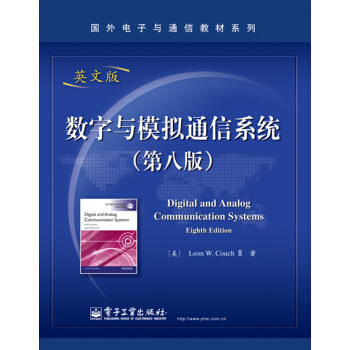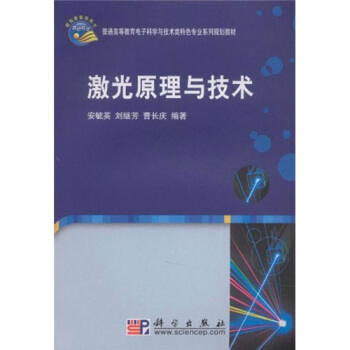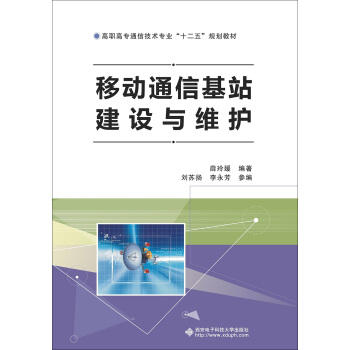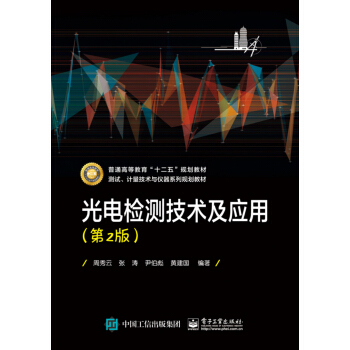

具体描述
内容简介
本书在前七版的基础上进行了修订与更新,系统介绍了现代通信系统的基本理论和最新发展技术。全书共分8章,内容包括:通信系统的基本概念;信号与频谱;基带脉冲与数字信号;带通信号传输原理与电路;调幅、 调频及数字调制系统;随机过程与频谱分析;噪声背景下通信系统的性能;有线及无线通信系统。每章都有一定的助学例题及大量的习题,部分例题及习题另配有 MATLAB 文件。此外,本书还包含 3 个附录:数学基本公式及图表;概率论及随机变量的简易教程;MATLAB 入门。此次新版中更新了所有 MATLAB 文件,新增了 100多道例题并给出了更多的习题答案。本书还给出了数字电视(DTV)技术、长期演进(LTE)系统、WiMAX 4G 蜂窝系统、个人通信系统及其应用等内容的介绍。目录
1INTRODUCTION 1?1 Historical Perspective1?2 Digital and Analog Sources and Systems
1?3 Deterministic and Random Waveforms
1?4 Organization of the Book
1?5 Use of a Personal Computer and MATLAB
1?6 Block Diagram of a Communication System
1?7 Frequency Allocations
1?8 Propagation of Electromagnetic Waves
1?9 Information Measure
1?10 Channel Capacity and Ideal Communication Systems
1?11 Coding
1?12 Preview
1?13 Study-Aid Examples
Problems
2SIGNALS AND SPECTRA
2?1 Properties of Signals and Noise
2?2 Fourier Transform and Spectra
2?3 Power Spectral Density and Autocorrelation Function
2?4 Orthogonal Series Representation of Signals and Noise
2?5 Fourier Series
2?6 Review of Linear Systems
2?7 Bandlimited Signals and Noise
2?8 Discrete Fourier Transform
2?9 Bandwidth of Signals
2?10 Summary
2?11 Study-Aid Examples
Problems
3BASEBAND PULSE AND DIGITAL SIGNALING
3?1 Introduction
3?2 Pulse Amplitude Modulation
3?3 Pulse Code Modulation
3?4 Digital Signaling
3?5 Line Codes and Spectra
3?6 Intersymbol Interference
3?7 Differential Pulse Code Modulation
3?8 Delta Modulation
3?9 Time-Division Multiplexing
3?10 Packet Transmission System
3?11 Pulse Time Modulation: Pulse Width Modulation and Pulse Position Modulation
3?12 Summary
3?13 Study-Aid Examples
Problems
4BANDPASS SIGNALING PRINCIPLES AND CIRCUITS
4?1 Complex Envelope Representation of Bandpass Waveforms
4?2 Representation of Modulated Signals
4?3 Spectrum of Bandpass Signals
4?4 Evaluation of Power
4?5 Bandpass Filtering and Linear Distortion
4?6 Bandpass Sampling Theorem
4?7 Received Signal Plus Noise
4?8 Classification of Filters and Amplifiers
4?9 Nonlinear Distortion
4?10 Limiters
4?11 Mixers, Up Converters, and Down Converters
4?12 Frequency
4?19 Study-Aid Examples
Problems
5AM, FM, AND DIGITAL MODULATED SYSTEMS
5?1 Amplitude Modulation
5?2 AM Broadcast Technical Standards and Digital AM Broadcasting
5?3 Double-Sideband Suppressed Carrier
5?4 Costas Loop and Squaring Loop
5?5 Asymmetric Sideband Signals
5?6 Phase Modulation and Frequency Modulation
5?7 Frequency-Division Multiplexing and FM Stereo
5?8 FM Broadcast Technical Standards and Digital FM Broadcasting
5?9 Binary Modulated Bandpass Signaling
5?10 Multilevel Modulated Bandpass Signaling
5?11 Minimum-Shift Keying and GMSK
5?12 Orthogonal Frequency Division Multiplexing (OFDM)
5?13 Spread Spectrum Systems
5?14 Summary
5?15 Study-Aid Examples
Problems
6RANDOM PROCESSES AND SPECTRAL ANALYSIS
6?1 Some Basic Definitions
6?2 Power Spectral Density
6?3 DC and RMS Values for Ergodic Random Processes
6?4 Linear Systems
6?5 Bandwidth Measures
6?6 The Gaussian Random Process
6?7 Bandpass Processes
6?8 Matched Filters
6?9 Summary
6?10 Appendix: Proof of Schwarz’s Inequality
6?11 Study-Aid Examples
Problems
7 PERFORMANCE OF COMMUNICATION SYSTEMS CORRUPTED BY NOISE
7?1 Error Probabilities for Binary Signaling
7?2 Performance of Baseband Binary Systems
7?3 Coherent Detection of Bandpass Binary Signals
7?4 Noncoherent Detection of Bandpass Binary Signals
7?5 Quadrature Phase-Shift Keying and Minimum-Shift Keying
7?6 Comparison of Digital Signaling Systems
7?7 Output Signal-to-Noise Ratio for PCM Systems
7?8 Output Signal-to-Noise Ratios for Analog Systems
7?9 Comparison of Analog Signaling Systems
7?10 Summary
7?11 Study-Aid Examples
Problems
8 WIRE AND WIRELESS COMMUNICATION APPLICATIONS
8?1 The Explosive Growth of Telecommunications
8?2 Telephone Systems
8?3 Digital Subscriber Lines (DSL)
8?4 Capacities of Public Switched Telephone Networks
8?5 Satellite Communication Systems
8?6 Link Budget Analysis
8?7 Fiber-Optic Systems
8?8 Cellular Telephone Systems
8?9 Television
8?10 Cable Data Modems
8?11 Wireless Data Networks
8?12 Summary
8?13 Study-Aid Examples
Problems
APPENDIX A MATHEMATICAL TECHNIQUES, IDENTITIES, AND TABLES
A?1 Trigonometry and Complex Numbers
A?2 Differential Calculus
A?3 Indeterminate Forms
A?4 Integral Calculus
A?5 Integral Tables
A?6 Series Expansions
A?7 Hilbert Transform Pairs
A?8 The Dirac Delta Function
A?9 Tabulation of Sa (x) = (sin x)x
A?10 Tabulation of Q (z)
APPENDIX BPROBABILITY AND RANDOM VARIABLES
B?1 Introduction
B?2 Sets
B?3 Probability and Relative Frequency
B?4 Random Variables
B?5 Cumulative Distribution Functions and Probability Density Functions
B?6 Ensemble Average and Moments
B?7 Examples of Important Distributions
B?8 Functional Transformations of Random Variables
B?9 Multivariate Statistics
Problems
APPENDIX C USING MATLAB
C?1 About the MATLAB M-Files
C?2 Quick Start for Running M-Files
C?3 Programming in MATLAB
REFERENCES
ANSWERS TO SELECTED PROBLEMS
INDEX
前言/序言
用户评价
我是一名通信系统的初级工程师,之前的工作经验主要集中在某个特定领域。最近为了拓展视野,我选择了《数字与模拟通信系统》(第八版,英文原版)这本书来系统性地学习。这本书的魅力在于它对通信系统各个组成部分的讲解都恰到好处,既有深度又不至于过于晦涩。我尤其欣赏它在介绍各种干扰和噪声的处理方式时,提供了非常实用的方法和分析工具。书中关于信道模型、噪声统计特性以及它们对系统性能的影响的阐述,对我理解通信链路的实际性能瓶颈非常有启发。此外,书中还涵盖了一些新兴的通信技术,虽然可能不是重点,但能够让我对整个通信技术的发展趋势有一个初步的认识。对于像我这样希望从理论到实践都有所提升的工程师来说,这本书无疑是一次宝贵的学习机会,它帮助我建立了一个更宏观的视角来审视我所从事的领域。
评分最近刚开始涉足通信领域,被《数字与模拟通信系统》(第八版,英文原版)这本书吸引了。虽然我还没来得及深入研读,但初步翻阅下来,这本书给我的感觉是既严谨又全面,绝对是为初学者和有一定基础的读者量身打造的。最让我印象深刻的是它那种循序渐进的教学方式。从最基础的信号概念讲起,逐步过渡到傅里叶分析、采样理论等核心概念,让我感觉一点点地打下了坚实的理论基础。书中大量的图示和清晰的解释,让那些抽象的数学公式不再那么令人望而生畏。我特别喜欢它对于各种通信系统的分类介绍,比如AM、FM、PCM等,每一类都进行了详细的原理剖析和性能分析,并且还涉及了实际应用中的一些考量,这对于我理解通信的整体框架非常有帮助。虽然我才刚开始,但可以预见,这本书会成为我未来学习道路上一位不可或缺的向导。
评分作为一名希望深入理解通信原理的在校大学生,我翻阅了《数字与模拟通信系统》(第八版,英文原版),并被其严谨的逻辑和丰富的实例所折服。这本书的优点在于其内容的深度和广度兼备。从信号的频谱分析到调制解调的各种方式,再到信道的特性以及噪声的影响,几乎涵盖了模拟和数字通信的所有核心概念。我特别喜欢书中对于概率论和随机过程在通信系统分析中的应用讲解,这部分内容是理解通信系统性能的关键。书中大量的图表清晰地展示了信号的变换过程和系统的工作原理,大大降低了理解难度。虽然有时候,特别是涉及到信息论和编码理论的部分,需要一些先修知识,但这本书的循序渐进的编排方式,即使是初学者也能通过努力逐步掌握。我认为这是一本非常优秀的教科书,它为我构建了一个扎实的通信理论基础。
评分我最近入手了《数字与模拟通信系统》(第八版,英文原版),作为一名对通信技术充满好奇的爱好者,我希望能从中获得一些系统性的知识。这本书给我的第一印象是它的“经典”感,仿佛包含了通信领域发展至今的许多重要基石。我尤其对书中关于信息论基础的章节感到惊叹,它以一种非常清晰的方式解释了香农的信息率失真定理等概念,让我第一次真正理解了信息传输的理论极限。虽然书中的数学公式比较多,但作者总能通过巧妙的图解和通俗的解释来帮助读者理解,这对于我这样的非专业人士来说是极大的福音。我还没有深入研究每一个细节,但仅从初步的浏览就能感受到,这本书对于理解数字通信的效率和可靠性是如何通过编码和调制等技术实现的,有着非常深刻的阐述。这是一本让我既感到挑战又充满收获的书。
评分我对《数字与模拟通信系统》(第八版,英文原版)这本书的整体印象是:内容厚重,知识密度极大,但又充满了实际应用导向。作为一名正在为通信工程的研究生入学考试做准备的学生,我发现这本书提供了一个非常扎实的理论框架,尤其是在数字通信部分,对信道编码、纠错码、调制解调技术等做了非常深入的讲解。书中不仅提供了大量的理论推导,还穿插了非常多的例子,这些例子往往能巧妙地连接理论和实际问题,让我更能体会到这些技术在现实世界中的价值。例如,在介绍信道编码时,书中详细阐述了不同编码方式的原理、性能以及它们的优缺点,这对于我理解如何提高通信的可靠性和效率至关重要。虽然有时会觉得某些章节的数学推导比较复杂,需要花费大量时间去理解,但一旦克服了这些困难,那种豁然开朗的感觉是无与伦比的。这本书绝对是一部值得反复研读的工具书。
评分好
评分一如既往的好! 这天女友打电话问我借本书,说她写作需要参考,我说我家没有,但我可以帮你找。我一边接电话一边就上网搜索,很快找到,立马告诉她网上京东有。她说我不会在网上买书啊。我嘲笑她一番,然后表示帮她买。很快就写好订单写好她的地址发出去了。果然第二天,书就送到她那儿了。她很高兴,我很得意。过了些日子,我自己又上网购书,但下订单后,左等右等不来。以前从来不超过一星期的。我正奇怪呢,刘静打电话来笑嘻嘻地说,哎,也不知道是谁,心眼儿那么好,又帮我订了好几本书,全是我想要的,太好了。我一听,连忙问她是哪几本?她一一说出书名,晕,那是我买的书啊。原来我下订单的时候,忘了把地址改过来,送到她那儿去了。这下可把她乐死了,把我先前对她的嘲笑全还给我了。不过京东送货确实很快。我和女友都很满意。好了,废话不说。|好了,我现在来说说这本书的观感吧,坐得冷板凳,耐得清寂夜,是为学之根本;独处不寂寞,游走自在乐,是为人之良质。潜心学问,风姿初显。喜爱独处,以窥视内心,反观自我;砥砺思想,磨砺意志。学与诗,文与思;青春之神思飞扬与学问之静寂孤独本是一种应该的、美好的平衡。在中国传统文人那里,诗人性情,学者本分,一脉相承久矣。现在讲究“术业有专攻”,分界逐渐明确,诗与学渐离渐远。此脉悬若一线,惜乎。我青年游历治学,晚年回首成书,记忆清新如初,景物历历如昨。挥发诗人情怀,摹写学者本分,意足矣,足已矣。好大一本书,是正版!各种不错!只是插图太多,有占篇符之嫌。故事很精彩,女儿很喜欢。书写的不错,能消除人的心瘾。目前已经戒烟第三天了,书拿到手挺有分量的,包装完好。还会继续来,一直就想买这本书,太谢谢京东了,发货神速,两天就到了,超给力的!5分!据悉,京东已经建立华北、华东、华南、西南、华中、东北六大物流中心,同时在全国超过360座城市建立核心城市配送站。是中国最大的综合网络零售商,是中国电子商务领域最受消费者欢迎和最具有影响力的电子商务网站之一,在线销售家电、数码通讯、电脑、家居百货、服装服饰、母婴、图书、食品、在线旅游等12大类数万个品牌百万种优质商品。选择京东。好了,现在给大家介绍两本好书:《电影学院037?电影语言的语法:电影剪辑的奥秘》编辑推荐:全球畅销三十余年并被翻译成数十种语言,被公认为讨论导演、摄影、剪辑等电影影像画面组织技巧方面最详密、实用的经典之作。|从实践出发阐明摄影机位、场面调度、剪辑等电影语言,为“用画面讲故事”奠定基础;百科全书式的工作手册,囊括拍摄中的所有基本设计方案,如对话场面、人物运动,使初学者能够迅速掌握专业方法;近500幅机位图、故事板贯穿全书,帮助读者一目了然地理解电影语言;对大量经典影片的典型段落进行多角度分析,如《西北偏北》、《放大》、《广岛之恋》、《桂河大桥》,深入揭示其中激动人心的奥秘;《致青年电影人的信:电影圈新人的入行锦囊》是中国老一辈电影教育工作者精心挑选的教材,在翻译、审订中投入了巨大的心力,译笔简明、准确、流畅,惠及无数电影人。二、你是否也有错过的挚爱?有些人,没有在一起,也好。如何遇见不要紧,要紧的是,如何告别。《莫失莫忘》并不简单是一本爱情小说,作者将众多社会事件作为故事的时代背景,俨然一部加长版的《倾城之恋》。“莫失莫忘”是贾宝玉那块通灵宝玉上刻的字,代表着一段看似完美实则无终的金玉良缘。叹人间美中不足今方信,纵然是举案齐眉,到底意难平。“相爱时不离不弃,分开后莫失莫忘”,这句话是秋微对感情的信仰,也是她对善缘的执念。才女作家秋微近几年最费心力写的一本小说,写作过程中由于太过投入,以至揪心痛楚到无法继续,直至完成最后一个字,大哭一场,才得以抽离出这份情感,也算是对自己前一段写作生涯的完美告别。
评分物流很快
评分一如既往的好! 这天女友打电话问我借本书,说她写作需要参考,我说我家没有,但我可以帮你找。我一边接电话一边就上网搜索,很快找到,立马告诉她网上京东有。她说我不会在网上买书啊。我嘲笑她一番,然后表示帮她买。很快就写好订单写好她的地址发出去了。果然第二天,书就送到她那儿了。她很高兴,我很得意。过了些日子,我自己又上网购书,但下订单后,左等右等不来。以前从来不超过一星期的。我正奇怪呢,刘静打电话来笑嘻嘻地说,哎,也不知道是谁,心眼儿那么好,又帮我订了好几本书,全是我想要的,太好了。我一听,连忙问她是哪几本?她一一说出书名,晕,那是我买的书啊。原来我下订单的时候,忘了把地址改过来,送到她那儿去了。这下可把她乐死了,把我先前对她的嘲笑全还给我了。不过京东送货确实很快。我和女友都很满意。好了,废话不说。|好了,我现在来说说这本书的观感吧,坐得冷板凳,耐得清寂夜,是为学之根本;独处不寂寞,游走自在乐,是为人之良质。潜心学问,风姿初显。喜爱独处,以窥视内心,反观自我;砥砺思想,磨砺意志。学与诗,文与思;青春之神思飞扬与学问之静寂孤独本是一种应该的、美好的平衡。在中国传统文人那里,诗人性情,学者本分,一脉相承久矣。现在讲究“术业有专攻”,分界逐渐明确,诗与学渐离渐远。此脉悬若一线,惜乎。我青年游历治学,晚年回首成书,记忆清新如初,景物历历如昨。挥发诗人情怀,摹写学者本分,意足矣,足已矣。好大一本书,是正版!各种不错!只是插图太多,有占篇符之嫌。故事很精彩,女儿很喜欢。书写的不错,能消除人的心瘾。目前已经戒烟第三天了,书拿到手挺有分量的,包装完好。还会继续来,一直就想买这本书,太谢谢京东了,发货神速,两天就到了,超给力的!5分!据悉,京东已经建立华北、华东、华南、西南、华中、东北六大物流中心,同时在全国超过360座城市建立核心城市配送站。是中国最大的综合网络零售商,是中国电子商务领域最受消费者欢迎和最具有影响力的电子商务网站之一,在线销售家电、数码通讯、电脑、家居百货、服装服饰、母婴、图书、食品、在线旅游等12大类数万个品牌百万种优质商品。选择京东。好了,现在给大家介绍两本好书:《电影学院037?电影语言的语法:电影剪辑的奥秘》编辑推荐:全球畅销三十余年并被翻译成数十种语言,被公认为讨论导演、摄影、剪辑等电影影像画面组织技巧方面最详密、实用的经典之作。|从实践出发阐明摄影机位、场面调度、剪辑等电影语言,为“用画面讲故事”奠定基础;百科全书式的工作手册,囊括拍摄中的所有基本设计方案,如对话场面、人物运动,使初学者能够迅速掌握专业方法;近500幅机位图、故事板贯穿全书,帮助读者一目了然地理解电影语言;对大量经典影片的典型段落进行多角度分析,如《西北偏北》、《放大》、《广岛之恋》、《桂河大桥》,深入揭示其中激动人心的奥秘;《致青年电影人的信:电影圈新人的入行锦囊》是中国老一辈电影教育工作者精心挑选的教材,在翻译、审订中投入了巨大的心力,译笔简明、准确、流畅,惠及无数电影人。二、你是否也有错过的挚爱?有些人,没有在一起,也好。如何遇见不要紧,要紧的是,如何告别。《莫失莫忘》并不简单是一本爱情小说,作者将众多社会事件作为故事的时代背景,俨然一部加长版的《倾城之恋》。“莫失莫忘”是贾宝玉那块通灵宝玉上刻的字,代表着一段看似完美实则无终的金玉良缘。叹人间美中不足今方信,纵然是举案齐眉,到底意难平。“相爱时不离不弃,分开后莫失莫忘”,这句话是秋微对感情的信仰,也是她对善缘的执念。才女作家秋微近几年最费心力写的一本小说,写作过程中由于太过投入,以至揪心痛楚到无法继续,直至完成最后一个字,大哭一场,才得以抽离出这份情感,也算是对自己前一段写作生涯的完美告别。
评分物流很快
评分一如既往的好! 这天女友打电话问我借本书,说她写作需要参考,我说我家没有,但我可以帮你找。我一边接电话一边就上网搜索,很快找到,立马告诉她网上京东有。她说我不会在网上买书啊。我嘲笑她一番,然后表示帮她买。很快就写好订单写好她的地址发出去了。果然第二天,书就送到她那儿了。她很高兴,我很得意。过了些日子,我自己又上网购书,但下订单后,左等右等不来。以前从来不超过一星期的。我正奇怪呢,刘静打电话来笑嘻嘻地说,哎,也不知道是谁,心眼儿那么好,又帮我订了好几本书,全是我想要的,太好了。我一听,连忙问她是哪几本?她一一说出书名,晕,那是我买的书啊。原来我下订单的时候,忘了把地址改过来,送到她那儿去了。这下可把她乐死了,把我先前对她的嘲笑全还给我了。不过京东送货确实很快。我和女友都很满意。好了,废话不说。|好了,我现在来说说这本书的观感吧,坐得冷板凳,耐得清寂夜,是为学之根本;独处不寂寞,游走自在乐,是为人之良质。潜心学问,风姿初显。喜爱独处,以窥视内心,反观自我;砥砺思想,磨砺意志。学与诗,文与思;青春之神思飞扬与学问之静寂孤独本是一种应该的、美好的平衡。在中国传统文人那里,诗人性情,学者本分,一脉相承久矣。现在讲究“术业有专攻”,分界逐渐明确,诗与学渐离渐远。此脉悬若一线,惜乎。我青年游历治学,晚年回首成书,记忆清新如初,景物历历如昨。挥发诗人情怀,摹写学者本分,意足矣,足已矣。好大一本书,是正版!各种不错!只是插图太多,有占篇符之嫌。故事很精彩,女儿很喜欢。书写的不错,能消除人的心瘾。目前已经戒烟第三天了,书拿到手挺有分量的,包装完好。还会继续来,一直就想买这本书,太谢谢京东了,发货神速,两天就到了,超给力的!5分!据悉,京东已经建立华北、华东、华南、西南、华中、东北六大物流中心,同时在全国超过360座城市建立核心城市配送站。是中国最大的综合网络零售商,是中国电子商务领域最受消费者欢迎和最具有影响力的电子商务网站之一,在线销售家电、数码通讯、电脑、家居百货、服装服饰、母婴、图书、食品、在线旅游等12大类数万个品牌百万种优质商品。选择京东。好了,现在给大家介绍两本好书:《电影学院037?电影语言的语法:电影剪辑的奥秘》编辑推荐:全球畅销三十余年并被翻译成数十种语言,被公认为讨论导演、摄影、剪辑等电影影像画面组织技巧方面最详密、实用的经典之作。|从实践出发阐明摄影机位、场面调度、剪辑等电影语言,为“用画面讲故事”奠定基础;百科全书式的工作手册,囊括拍摄中的所有基本设计方案,如对话场面、人物运动,使初学者能够迅速掌握专业方法;近500幅机位图、故事板贯穿全书,帮助读者一目了然地理解电影语言;对大量经典影片的典型段落进行多角度分析,如《西北偏北》、《放大》、《广岛之恋》、《桂河大桥》,深入揭示其中激动人心的奥秘;《致青年电影人的信:电影圈新人的入行锦囊》是中国老一辈电影教育工作者精心挑选的教材,在翻译、审订中投入了巨大的心力,译笔简明、准确、流畅,惠及无数电影人。二、你是否也有错过的挚爱?有些人,没有在一起,也好。如何遇见不要紧,要紧的是,如何告别。《莫失莫忘》并不简单是一本爱情小说,作者将众多社会事件作为故事的时代背景,俨然一部加长版的《倾城之恋》。“莫失莫忘”是贾宝玉那块通灵宝玉上刻的字,代表着一段看似完美实则无终的金玉良缘。叹人间美中不足今方信,纵然是举案齐眉,到底意难平。“相爱时不离不弃,分开后莫失莫忘”,这句话是秋微对感情的信仰,也是她对善缘的执念。才女作家秋微近几年最费心力写的一本小说,写作过程中由于太过投入,以至揪心痛楚到无法继续,直至完成最后一个字,大哭一场,才得以抽离出这份情感,也算是对自己前一段写作生涯的完美告别。
评分买来收藏,300-10活动
评分好
评分英文版的,看起来还是有些吃力
相关图书
本站所有内容均为互联网搜索引擎提供的公开搜索信息,本站不存储任何数据与内容,任何内容与数据均与本站无关,如有需要请联系相关搜索引擎包括但不限于百度,google,bing,sogou 等,本站所有链接都为正版商品购买链接。
© 2025 windowsfront.com All Rights Reserved. 静流书站 版权所有










![电路基础/普通高等教育电气电子类工程应用型“十二五”规划教材 [Fundamentals of Electric Circuis] pdf epub mobi 电子书 下载](https://pic.windowsfront.com/11593393/549161b9N37bd41a0.jpg)


![运动多站无源定位技术 [Passive Location of Multiple Moving Observers] pdf epub mobi 电子书 下载](https://pic.windowsfront.com/11681963/5540260dNe84659a8.jpg)






